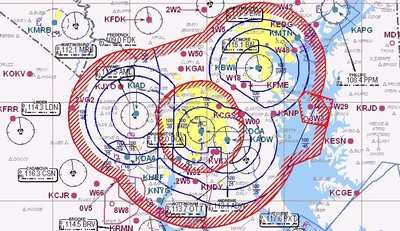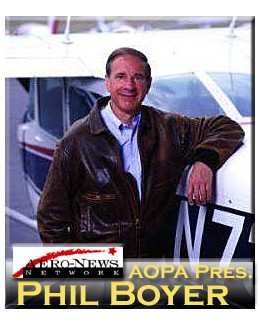Asking Members To Oppose "Burdensome" Air Defense
Identification Zone
 The AOPA this week took the highly
unusual step of mailing a National Pilot Alert to its members,
asking them to actively oppose the FAA proposal to make the
restrictive Washington, DC, air defense identification zone (ADIZ)
permanent.
The AOPA this week took the highly
unusual step of mailing a National Pilot Alert to its members,
asking them to actively oppose the FAA proposal to make the
restrictive Washington, DC, air defense identification zone (ADIZ)
permanent.
The "temporary" ADIZ has been a 3,000 square mile permanent
fixture of the airspace around the cities of Washington, DC, and
Baltimore since it was hastily imposed over a weekend during the
run-up to war in Iraq two and a half years ago. A similar ADIZ has
been imposed several times around New York City, but it has lasted
only a short time in each case. Although the NY ADIZ was removed
once the security threat level decreased, the Washington DC-area
ADIZ has remained. Some security officials have indicated they'd
like to see ADIZ restrictions around other major US cities.
"The threat of a permanent ADIZ, not only here but in other
areas of the country, is very real," said AOPA President Phil
Boyer. "If the FAA makes the Washington, DC, ADIZ permanent, it
will set a dangerous precedent, creating the possibility of overly
burdensome flight restrictions around major US cities."

AOPA said the threat is so serious that it has issued only its
third National Pilot Alert in more than a decade. The association
is asking every one of its more than 406,000 members to lodge a
protest with the FAA and send a copy to Congress.
To fly in the ADIZ, pilots need to file a flight plan with an
FAA employee at a Flight Service Station (FSS), obtain a code to
enter in the transponder of the aircraft, get permission from air
traffic control (ATC) to enter the airspace, and remain in contact
with ATC while in the ADIZ, all of which stretches FAA resources
too thinly.
"The Washington ADIZ tripled air traffic controller workload,
costing the taxpayers an additional $11 million a year," said
Boyer. "But the FAA didn't add substantially to its resources."
Pilots who currently fly in and around the ADIZ must deal with
long waits to get through on the telephone to ATC, flight plans
lost by ATC, and getting stranded outside of the ADIZ due to minor
technical glitches. In addition, these pilots face severe
enforcement penalties - including the risk of being shot down - for
harmless technical or procedural errors made while trying to follow
the highly complex procedures.
Boyer readily acknowledged the need to protect the nation's
capital where the critical areas, including Congress, the White
House, the Pentagon, and every significant federal agency
headquarters are covered by the Flight Restricted Zone, or FRZ.
This highly sensitive area is well protected with multiple radar
systems, laser warning systems, anti-aircraft missile batteries,
man-portable anti-aircraft defense systems, and US Customs and
Border Protection and US Air Force interceptor aircraft.
 "The need for the FRZ is
understandable and necessary - and it works," said Boyer. "The
ADIZ, on the other hand, is ill conceived, poorly designed,
completely unworkable, and totally unnecessary. It unreasonably
restricts freedom of travel and has severely crippled the economic
viability of hundreds of businesses."
"The need for the FRZ is
understandable and necessary - and it works," said Boyer. "The
ADIZ, on the other hand, is ill conceived, poorly designed,
completely unworkable, and totally unnecessary. It unreasonably
restricts freedom of travel and has severely crippled the economic
viability of hundreds of businesses."
The danger to the nation's capital posed by GA aircraft is
minimal, the FAA said. A 2,000-pound, four-seat Cessna aircraft is
used by pilots for personal and business travel much the same way
that Americans use their family car. A small GA aircraft is vastly
different than a 500,000-pound Boeing 747 airliner. GA aircraft do
not have the mass or load-carrying capability to make good weapons,
which is why a GA aircraft has never been used in an act of
terrorism anywhere in the world.
The restrictions in the 3,000-square-nautical-mile Washington,
DC, ADIZ surrounding the FRZ "are excessive and do little to
increase security. There are simple and rational procedures that
can provide adequate security without setting a dangerous precedent
that threatens GA pilots everywhere. It's an unmanageable,
one-size-fits-all solution that creates significantly more problems
than it solves," said Boyer.
 ANN's Daily Aero-Term (04.20.24): Light Gun
ANN's Daily Aero-Term (04.20.24): Light Gun Aero-News: Quote of the Day (04.20.24)
Aero-News: Quote of the Day (04.20.24) ANN's Daily Aero-Linx (04.21.24)
ANN's Daily Aero-Linx (04.21.24) Aero-News: Quote of the Day (04.21.24)
Aero-News: Quote of the Day (04.21.24) ANN's Daily Aero-Term (04.21.24): Aircraft Conflict
ANN's Daily Aero-Term (04.21.24): Aircraft Conflict





